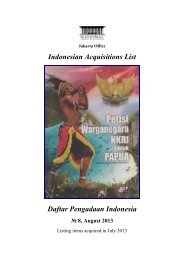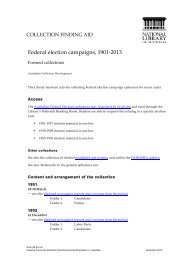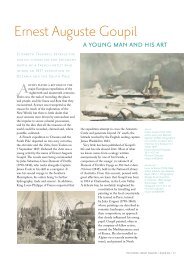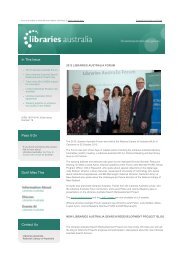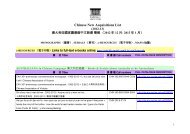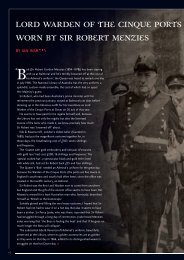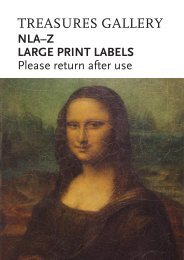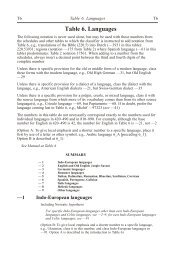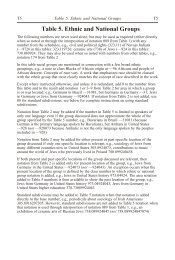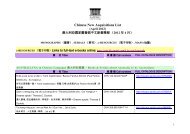Download the National Library Magazine - National Library of ...
Download the National Library Magazine - National Library of ...
Download the National Library Magazine - National Library of ...
Create successful ePaper yourself
Turn your PDF publications into a flip-book with our unique Google optimized e-Paper software.
JOANNA GILMOUR PONDERS THE LEGACY LEFT BY ARTIST WILLIAM HENRY FERNYHOUGH’S<br />
PORTRAITS OF INDIGENOUS PEOPLE<br />
When Charles Darwin sailed into<br />
Sydney Harbour in January 1836,<br />
he was ra<strong>the</strong>r impressed with what<br />
he saw. A harbour he considered ‘fine and<br />
spacious’, and a town—with villas and<br />
cottages ‘scattered along <strong>the</strong> beach’ and streets<br />
that were ‘regular, broad, clean and kept in<br />
excellent order’—which he asserted to be ‘a<br />
most magnificent testimony to <strong>the</strong> power <strong>of</strong><br />
<strong>the</strong> British nation’. Sydney in 1836, according<br />
to <strong>the</strong> gentleman–naturalist aboard HMS<br />
Beagle’s round-<strong>the</strong>-world surveying voyage,<br />
could be ‘favourably compared to <strong>the</strong> large<br />
suburbs, which stretch out from London<br />
and a few o<strong>the</strong>r great towns in England’.<br />
He expressed equal amounts <strong>of</strong> surprise<br />
and distaste at <strong>the</strong> evidence <strong>of</strong> its rapid<br />
development and rude economic health.<br />
By 1836, a mere 50 years since <strong>the</strong> British<br />
government had made <strong>the</strong> decision to colonise<br />
New South Wales, Sydney was indeed a<br />
thriving place. Its function and reputation<br />
as a vast prison was receding in <strong>the</strong> face <strong>of</strong><br />
<strong>the</strong> arrival <strong>of</strong> increasing numbers <strong>of</strong> free<br />
settlers and <strong>the</strong> entry into <strong>the</strong> community <strong>of</strong><br />
‘respectable’ ex-convicts and <strong>the</strong>ir families. It<br />
was as much a place <strong>of</strong> opportunity as <strong>of</strong> exile,<br />
a country where even those <strong>of</strong> modest means<br />
and humble origins might create comfortable,<br />
pr<strong>of</strong>itable lives. As a result, <strong>the</strong> settlement<br />
was not entirely <strong>the</strong> pinched and undesirable<br />
convict colony <strong>of</strong> popular perception, but<br />
a complex one characterised by a healthy<br />
consumer culture and wherein various<br />
industries were growing.<br />
A local art scene was one such industry, and<br />
artists were included in <strong>the</strong> numbers <strong>of</strong> those<br />
choosing Sydney as home. Darwin’s friend<br />
and erstwhile shipmate, Conrad Martens<br />
(1801–1878), for instance, had arrived in<br />
1835 and decided to stay and capitalise on<br />
<strong>the</strong> colonists’ pretensions and new-found<br />
wealth, while <strong>the</strong> ex-convict Charles Rodius<br />
(1802–1860), transported for <strong>the</strong>ft in 1829,<br />
stayed on beyond <strong>the</strong> expiration <strong>of</strong> his<br />
sentence, fashioning a relatively successful<br />
career in portraiture and printmaking.<br />
Though <strong>the</strong> market may have been relatively<br />
small, painters could make a living, securing<br />
commissions from wealthy settlers requiring<br />
portraits <strong>of</strong> <strong>the</strong>ir wives, houses and horses.<br />
Printmakers like Rodius benefited from <strong>the</strong><br />
robust trade in affordable, souvenir-style<br />
images, with <strong>the</strong> advent <strong>of</strong> <strong>the</strong> lithograph<br />
making art something acquirable by those<br />
occupying less elevated levels <strong>of</strong> society. The<br />
affordability and reach <strong>of</strong> <strong>the</strong> printed image,<br />
coupled with an increasing tendency on <strong>the</strong><br />
part <strong>of</strong> colonists to advertise or make sense<br />
<strong>of</strong> <strong>the</strong>ir place in <strong>the</strong> new world, conspired<br />
to augment <strong>the</strong> local lithography trade,<br />
introduced to Sydney in <strong>the</strong> mid-1820s<br />
through a lithographic press brought to<br />
Australia at <strong>the</strong> behest <strong>of</strong> <strong>the</strong> <strong>the</strong>n Governor,<br />
Thomas Brisbane. The same year, 1836, is<br />
also <strong>the</strong> year in which a printmaker named<br />
William Henry Fernyhough (1809–1849)<br />
arrived in Sydney, and <strong>the</strong> year in which his<br />
best known work—A Series <strong>of</strong> Twelve Pr<strong>of</strong>ile<br />
Portraits <strong>of</strong> <strong>the</strong> Aborigines <strong>of</strong> New South Wales—<br />
was first published.<br />
Staffordshire-born, Fernyhough is believed<br />
to have worked as an armorial painter, and<br />
had obviously gained some experience <strong>of</strong><br />
printmaking before emigrating to Australia.<br />
Soon after arriving in Sydney, he found<br />
employment with John Gardner Austin<br />
(active 1834–c. 1842), a lithographer who had<br />
established a successful printery following his<br />
own relocation from England to Sydney in<br />
June 1834. In keeping with <strong>the</strong> opportunistic,<br />
market-savvy mood <strong>of</strong> o<strong>the</strong>r Sydney businesses<br />
<strong>of</strong> <strong>the</strong> period, Fernyhough wasted little<br />
time in producing this series <strong>of</strong> portraits<br />
that was seemingly guaranteed to sell. As<br />
Sydney newspaper The Colonist reported in<br />
September 1836:<br />
A gentleman, named Fernyhough,<br />
who has not been long in this colony,<br />
has commenced business in Bridge<br />
Street, as an artist—one <strong>of</strong> <strong>the</strong> first<br />
productions <strong>of</strong> his genius has just<br />
made its appearance, in <strong>the</strong> shape <strong>of</strong><br />
twelve lithographic drawings <strong>of</strong> <strong>the</strong><br />
Aborigines <strong>of</strong> New South Wales.<br />
For ten shillings and sixpence,<br />
purchasers acquired silhouette<br />
or ‘pr<strong>of</strong>ile portraits’ <strong>of</strong> some <strong>of</strong><br />
colonial-era Sydney’s most visible<br />
and significant Indigenous leaders,<br />
opposite from left<br />
William Henry Fernyhough<br />
(1809–1849)<br />
Bungaree, Late Chief <strong>of</strong> <strong>the</strong><br />
Broken Bay Tribe Sydney 1836<br />
lithograph; 25.8 x 18.6 cm<br />
Pictures Collection<br />
nla.pic-vn4737955<br />
William Henry Fernyhough<br />
(1809–1849)<br />
Gooseberry, Widow <strong>of</strong> King<br />
Bungaree 1836<br />
lithograph; 25 x 18 cm<br />
Pictures Collection<br />
nla.pic-vn3789297<br />
William Henry Fernyhough<br />
(1809–1849)<br />
Piper, <strong>the</strong> Native Who<br />
Accompanied Major Mitchell<br />
in His Expedition to <strong>the</strong> Interior<br />
1836<br />
lithograph; 25 x 18 cm<br />
Pictures Collection<br />
nla.pic-vn3789425<br />
background<br />
John Glover (1767–1849)<br />
On <strong>the</strong> Ouse River c. 1834<br />
pen, ink and wash<br />
17.8 x 26.5 cm<br />
Pictures Collection<br />
nla.pic-an4622225<br />
below<br />
Charles Rodius (1802–1860)<br />
Nunberri, Chief <strong>of</strong> <strong>the</strong><br />
Nunnerahs, N.S. Wales 1834<br />
lithograph; 17.7 x 12 cm<br />
Pictures Collection<br />
nla.pic-an8953966<br />
THE NATIONAL LIBRARY OF AUSTRALIA MAGAZINE :: DECEMBER 2013 :: 9



